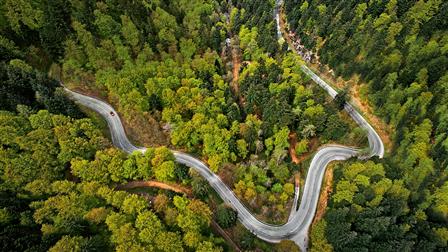Time Travel
Weighty relics: The lovely photographic memories of his father, Edgar, weigh nearly 10 kilos. Jürgen Barth likes to revisit the brown leather tome and peruse moments from the past.
A road usually connects two places. But it can also link two lives—such as those of racing legends Edgar and Jürgen Barth. Edgar Barth won the 1957 Schauinsland hill-climb race in a
“Training was mainly done at night,” says Jürgen Barth. “It was relatively safe to follow the ideal line, because the headlights of oncoming cars made it possible to see them in good time.” Just 9 years old at the time, the now 68-year-old Barth still remembers it well. He was allowed to come along and sit in the passenger seat as his father Edgar roared up the 173 corners of the 12-kilometer mountain road southeast of Freiburg with breathtaking speed. “Those were naturally magic moments for a young boy,” recalls Jürgen, who grew up in the motor-racing world and later became one of the best in the sport himself.
Jürgen Barth is sitting at a table in the hotel Die Halde on the summit plateau of the Schauinsland mountain; before him lies a gigantic, fawn-brown leather tome. The album weighs nearly 10 kilograms and just barely fits in the luggage compartment of the 718
A treasure trove of recollections
Jürgen opens the heavy cover of the album as one would the top of a treasure chest. The picture book is full of memories and stories that capture and reflect his father Edgar’s entire racing career. Edgar Barth started racing motorcycles in 1934 and was among the pioneers of motor racing in East Germany after World War II. He raced for
Some of the black-and-white photos include a little boy. In one of them, he sports an adorable peaked cap. “That’s me,” says Jürgen Barth. He flips through the pages, pausing thoughtfully and smiling from time to time as he points to the most important stations in his father’s career, such as his victory in the Autobahnspinne Dresden in 1953, the
![[+]](https://staging.www.porsche.com/filestore/image/multimedia/none/christophorus-issue378-article10-content-01/normal/38c5d2e8-7673-11e6-9a3c-0019999cd470/porsche-normal.jpg)
Familiar sound: “Some of the engine sounds in the new 718
Passion: No time for a break at Holzschlägermatte (below); the corners prove too tempting for the 718
“Some of the engine sounds in the new 718
“You know there’s a turbo behind your back propelling you, but it feels like a naturally aspirated engine.” The classic among hill-climb races, the way up to the panoramic summit at 1,284 meters is the ideal road on which to familiarize oneself with the
Son of the king of the mountain
Jürgen Barth knows the
![[+]](https://staging.www.porsche.com/filestore/image/multimedia/none/christophorus-issue378-article10-content-02/normal/38c5d2e9-7673-11e6-9a3c-0019999cd470/porsche-normal.jpg)
Nürburgring: Back in 1927, Rudolf Caracciola was the first winner on the legendary track to receive a ring in the shape of the circuit. In 1980, Jürgen Barth and Rolf Stommelen were the last. The wonderful memories are now along for the ride—on Barth’s right ring finger.
“Maybe driving fast was in my blood. How I really learned it, though, was through the many opportunities that I had as a driver of the service vehicle, such as in the Safari Rally in Kenya for Björn Waldegård,” recalls Barth. Because he also had a detailed understanding of the car’s technology, he was able to drive fast, yet gently, which few others could do—an ability that made him one of the finest endurance drivers of his era. Today, Barth says that “the art of racing is not to drive 100 percent at one point in the race and post the fastest lap, but to go as close to 90 percent as you can for the whole race. If you can manage that, then you’re really fast.”
Mechanic in the race car
Before becoming a race-car driver, Jürgen Barth trained for a practical career. His father, who died in 1965, insisted on it, and his son took his advice. First, he apprenticed as a car mechanic with
On June 12, 1977, Jürgen Barth steered a smoking
![[+]](https://staging.www.porsche.com/filestore/image/multimedia/none/christophorus-issue378-article10-content-03/normal/3f8f8183-7673-11e6-9a3c-0019999cd470/porsche-normal.jpg)
Ring of the North Loop
En route to Alsace: A car that’s made for attacking and rambling at the same time, according to expert driver Jürgen Barth. He enjoys every corner on the Schauinsland and is looking forward to dinner in neighboring Alsace afterwards.
When you sit with Jürgen Barth and talk about old times and the new 718
Jürgen Barth is back in the 718
Promenade on Schauinsland mountain
“The 718
Text by Sven Freese
Photos by Steffen Jahn
The Schauinsland Hill-Climb Race
In the Middle Ages, people mined for silver and lead on the Schauinsland. Later, lumberjacks plied their trade on the mountain’s slopes. To facilitate the transport of wood down into the valley, the city of Freiburg built a road on its local mountain. It was finished in 1896. Some two decades later, the old logging road caught the eye of some of Freiburg’s motor-racing enthusiasts. The result: on August 16, 1925, the first race—dubbed the “ADAC Berg-Rekord”—was held on the Schauinsland. In total, 126 motorcycles and 72 cars took part. The winner covered the approximately 12-kilometer course, with its 173 corners and maximum grade of 12 percent, with an average speed of 62.3 km/h. The race immediately became a public sensation. In its heyday, more than 10,000 spectators thronged the roadside to catch a glimpse of the world racing elite, private drivers, and local favorites testing their skills. The ranks of the winners of the 38 Schauinsland races include the likes of Rudolf Caracciola, Hans Stuck, Bernd Rosemeyer, Hans Herrmann, Edgar Barth, Gerhard Mitter, Rolf Stommelen, and Mario Ketterer. On July 8, 1979, Ketterer posted an average speed of 134.76 km/h, setting a record that still stands today. The last Schauinsland race was held in 1984 on a shortened course. Strict environmental and safety regulations ultimately sealed the fate of the event. Today, races are held at irregular intervals on the Schauinsland with classic race cars and high-powered celebrity participation.
![[+]](https://staging.www.porsche.com/filestore/image/multimedia/none/christophorus-issue378-article10-margin-01/normal/91c4531c-75c2-11e6-9a3c-0019999cd470/porsche-normal.jpg)
![[+]](https://staging.www.porsche.com/filestore/image/multimedia/none/christophorus-issue378-article10-margin-02/normal/abb338e1-75c2-11e6-9a3c-0019999cd470/porsche-normal.jpg)
![[+]](https://staging.www.porsche.com/filestore/image/multimedia/none/christophorus-issue378-article10-margin-03/normal/abb338e2-75c2-11e6-9a3c-0019999cd470/porsche-normal.jpg)
![[+]](https://staging.www.porsche.com/filestore/image/multimedia/none/christophorus-issue378-article10-margin-04/normal/b45b5ca5-75c2-11e6-9a3c-0019999cd470/porsche-normal.jpg)
![[+]](https://staging.www.porsche.com/filestore/image/multimedia/none/christophorus-issue378-article10-margin-05/normal/b45b5ca6-75c2-11e6-9a3c-0019999cd470/porsche-normal.jpg)








